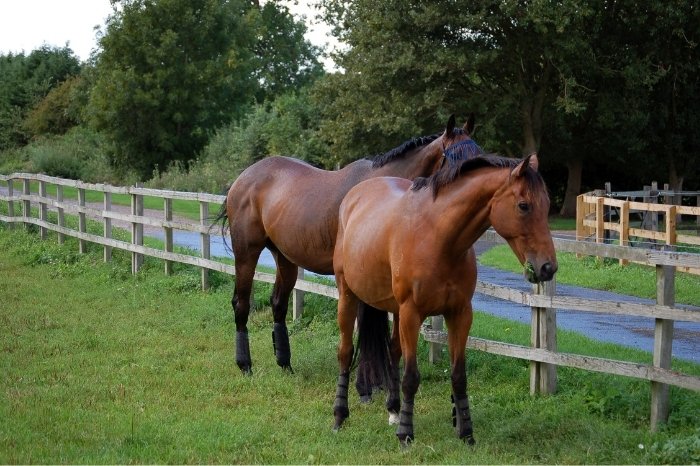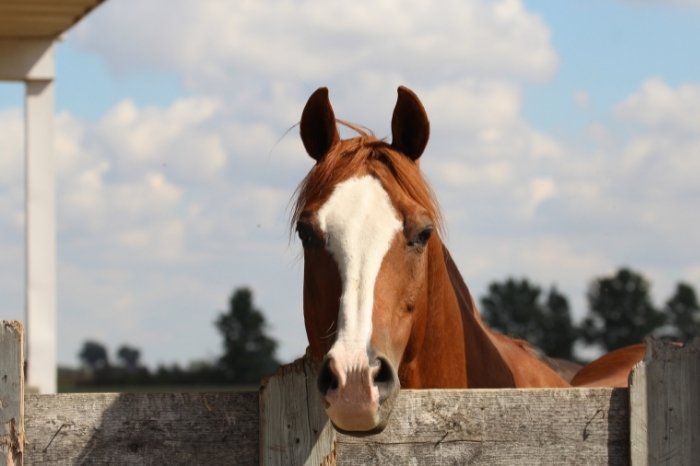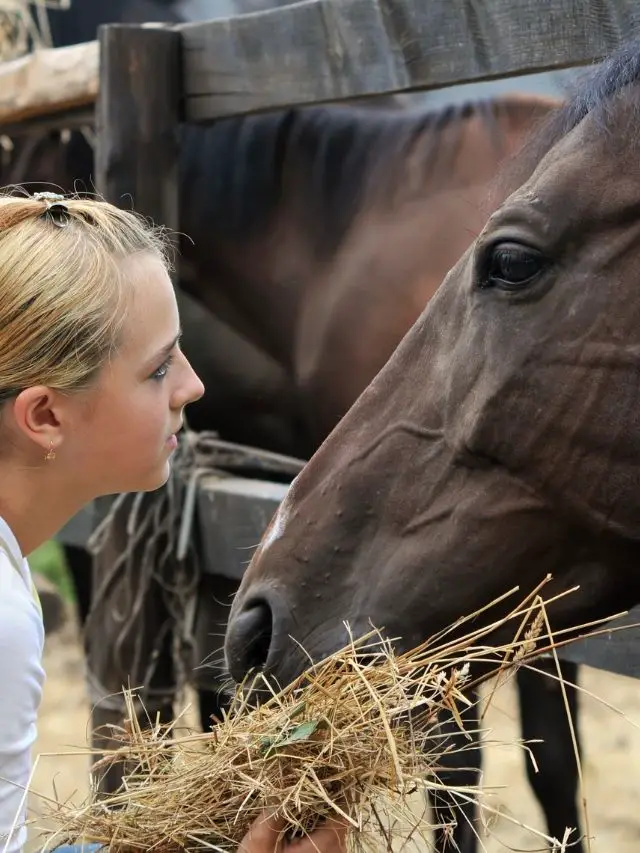Last Updated on April 17, 2023
If you’re new to the world of horses, terms like ‘OTTB’ can be very confusing. So, what does OTTB mean in horses? And is an OTTB horse the right choice for you?
In recent years, OTTB horses have grown in popularity, with many people choosing to take on one of these horses. OTTB horses can be a big challenge to retrain, but the time spent on these horses can bring huge rewards over time. Let’s take a look at OTTB horses and what they are all about!
What Does OTTB Mean in Horses?
OTTB means ‘Off The Track Thoroughbred’. These are horses that have been retired from the Thoroughbred racing industry and then go on to be retrained in a new equestrian discipline. OTTB horses may have raced for years or may have never set foot on a racetrack. They may have retired due to injury, or simply because they were not competitive or fast enough to race.

What is an OTTB mare?
An OTTB mare is a female Thoroughbred horse that has been retired from racing and is destined for another equestrian career. OTTB mares may be harder to come across than geldings, as many of them are instead retired to stud as broodmares. This is particularly common if the mare has an excellent racing pedigree or showed promise as a racehorse.
It is not uncommon for Thoroughbred mares to have a short racing career, then be retired to breed more foals for racing. At some point, she may then be retired from stud, and go on to be retrained as a riding horse.
What Can OTTB Horses Be Used for?
Retrained Thoroughbreds can make exceptionally good riding horses, with many of them going on to compete at top-level competitions. Thoroughbreds are strong, fast, athletic, and have plenty of stamina – perfect for many equestrian sports!
Some of the top-level OTTB horses include:
- Blackfoot Mystery is a gelding who raced three times before being retired and retrained for eventing. He then went on to compete at the 2016 Olympics!
- Tizrobertcharles was a winner on the track but then went on to become a police horse in South Florida.
- Fighting Ferrari became a movie star with the title role in ‘Seabiscuit’, and now assists children with Autism in California.
- Idle Dice was sold from the race track at the age of 4 after he proved to be unsuccessful. He went on to become a top-level showjumper, winning 31 Grand Prix titles.
However, if you’re not looking for a sporty horse, don’t rule out an OTTB as your next mount. There are plenty of Thoroughbreds out there with a calm and dependable nature – these are the ones who just didn’t want to race! Some OTTB horses can make lovely pleasure riding horses, and will quite happily stroll along trails for hours at a time.
Is It Easy to Train an OTTB Horse?
OTTB horses will have only been trained to do one thing – run as fast as possible! They are broken and trained in very different ways from conventional riding horses and require a long period of retraining. They may not understand basic aids and need an experienced rider to help them learn what is expected of them.
101 Ground Training Exercises for Every Horse & Handler
When a Thoroughbred retires from the racetrack, it will be given several weeks or months to rest and relax. This is referred to as the ‘letting down’ period, and it allows the horse to unwind physically as well as mentally.
After this period, the Thoroughbred will be slowly and gently retrained to become a riding horse. How long this takes and how difficult this process varies widely according to the horse’s temperament and age.
How Much Does an OTTB Horse Cost?
Although it is possible to buy an OTTB horse privately, it is better to go through an approved organization that will have assessed and trained the horse before rehoming it.
The Thoroughbred Aftercare Alliance has brought together a list of approved trainers for people who wish to take on an OTTB horse. These are accredited organizations that will retrain retired racehorses, and then make them available to adopt.
Adoption fees for OTTBs can range from a few thousand dollars down to just a few hundred dollars. The fee depends on a variety of factors, including the soundness, confirmation, and level of training of the horse. These organizations receive funding that allows them to keep adoption fees as low as possible, however, retraining these horses takes time and money.
By adopting a horse from an approved OTTB trainer you can be sure that the horse has been thoroughly evaluated, and the organization will try its best to match the right horse to the right home. They will also support the new owner after adoption, helping to create a successful and long-lasting partnership.
Where Can I Find an OTTB Horse for Sale?
If you don’t want to adopt an OTTB horse, you will find ex-racing Thoroughbreds for sale in classified adverts and at horse auctions. However, a responsible racehorse trainer would always take their retired horses to an approved organization for retraining. Horses sold by other methods may be unpredictable or even suffer from long-term injury or lameness.
If you choose to buy rather than adopt an OTTB horse, make sure to get it thoroughly checked by a veterinarian first. It may sensible to ask for a trial period before committing to buy, so you can fully assess the temperament and suitability of the horse.
What is Better – An OTTB Mare or an OTTB Gelding?
Many of us prefer one gender of a horse to another, but they both have their advantages and disadvantages. As with all horses, many factors can affect temperament and performance, but gender does make a big difference.
Normally, riders and trainers who are looking for a sensible and predictable horse will choose a gelding. Geldings are also good for relaxing equine activities such as trail riding, happy to wander along for hours at a time. However, remember this is a Thoroughbred – you should not expect to live the quiet life with an OTTB gelding!
Mares are often chosen by riders or trainers who enjoy a challenge and a bit of ‘fizziness’. Mares are less forgiving of any mistakes, meaning the rider must concentrate at all times. And of course, with OTTB mares, we’ve got the added complications of the ever-changing hormones!
10 Reasons Not to Buy an OTTB
OK, so we’ve told you all the great points about buying an OTTB horse, but are there any downsides to this option? Yes, definitely! Let’s take a look at some of the most common reasons why not to buy an OTTB:
1: High risk of lameness
Sadly, most Thoroughbred horses are broken to ride and raced at a young age, before they are physically mature. This puts them at a high risk of musculoskeletal injuries, which can cause problems throughout their lives. Many Thoroughbreds also suffer from poor limb and hoof conformation, which can lead to long-term lameness problems.
2: Increased care costs
Sadly, Thoroughbreds do not tend to be cheap to keep! These horses do not thrive if kept out at pasture 24/7 and tend to need time in a barn or stable, particularly during the colder months. They also have a fast metabolism and need plenty of good quality hay/haylage and feed.
3: High risk of behavioral problems
Thoroughbred racehorses spend many hours per day confined to a stall, which can lead to commonplace stable vices such as weaving, wind-sucking, cribbing, and box-walking. Sadly, no matter how much you pamper and care for your OTTB, these vices may never be cured and can lead to long-term health problems.
4: Increased farrier fees
Thoroughbreds are notorious for their poor hoof quality, and many cannot be kept unshod. This means you need to budget for regular reshoeing of your horse, leading to increased farrier fees. It is not uncommon for Thoroughbreds to require specialist shoes such as bar shoes, leading to even higher costs.
5: Long retirement
Taking on a horse is a huge commitment, and when your OTTB needs to be retired from ridden work, you will need to continue to care for it throughout the remainder of its life. Unfortunately, many OTTBs are retired early due to health problems, leading to a longer retirement.
6: Retraining costs
If you are not experienced enough to retrain an OTTB yourself, you will need to pay a trainer to do the job for you. This may involve boarding fees and can be an expensive and lengthy process.
7: Not suitable for novice riders
No matter how calm and placid an OTTB is, most reputable trainers would never allow a beginner or novice rider to ride one. Thoroughbreds can be lively and unpredictable and are not very forgiving if a learner rider makes an innocent mistake.
8: Not suitable for all equestrian pursuits
Thoroughbreds are designed to run fast, in a straight line, or around a circuit, and perhaps clear jumps at high speed. This means that not all OTTBs will go on to be great dressage, showjumping, or trail riding horses, as they just cannot mentally or physically cope with the demands of their new role.
9: Not suitable for heavier riders
Although Thoroughbreds are relatively large horses, they are not particularly strong and cannot carry heavier riders.
10: Unpredictable temperament
While many people love the unpredictable and feisty temperament of a Thoroughbred, they aren’t for everyone! These horses often like to push boundaries and see what they can get away with, and require patient and consistent training methods.
Summary – What Does OTTB Mean in Horses
So, as we have learned, an OTTB horse is a Thoroughbred which has retired from racing and has been retrained in a new equestrian discipline. OTTB horses can be a challenge to retrain but can become reliable and fun riding horses. Some organizations hold events and competitions for OTTB horses.
We would love to hear about your experiences with OTTB horses – have you ever owned or retrained one? Perhaps you are thinking of buying an OTTB horse but have a few questions you’d like us to answer. Add a comment below this post and we’ll get back to you!
Frequently Asked Question

Kate Chalmers is a qualified veterinary nurse who has specialized in horse care for the vast majority of her career. She has been around horses since she was a child, starting out riding ponies and helping out at the local stables before going on to college to study Horse Care & Management. She has backed and trained many horses during her lifetime and competed in various equestrian sports at different levels.
After Kate qualified as a veterinary nurse, she provided nursing care to the patients of a large equine veterinary hospital for many years. She then went on to teach horse care and veterinary nursing at one of the top colleges in the country. This has led to an in-depth knowledge of the care needs of horses and their various medical ailments, as well as a life-long passion for educating horse owners on how to provide the best possible care for their four-legged friends.
Kate Chalmers BSc (Hons) CVN, Dip AVN (Equine) Dip HE CVN EVN VN A1 PGCE



